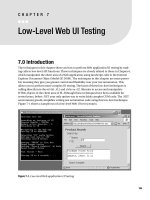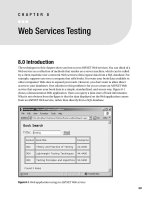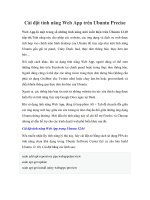Web app testing using knockout JS
Bạn đang xem bản rút gọn của tài liệu. Xem và tải ngay bản đầy đủ của tài liệu tại đây (1.72 MB, 154 trang )
www.it-ebooks.info
Web App Testing Using
Knockout.JS
Design, implement, and maintain a fully tested
JavaScript web application using Knockout.JS
Roberto Messora
BIRMINGHAM - MUMBAI
www.it-ebooks.info
Web App Testing Using Knockout.JS
Copyright © 2014 Packt Publishing
All rights reserved. No part of this book may be reproduced, stored in a retrieval
system, or transmitted in any form or by any means, without the prior written
permission of the publisher, except in the case of brief quotations embedded in
critical articles or reviews.
Every effort has been made in the preparation of this book to ensure the accuracy
of the information presented. However, the information contained in this book is
sold without warranty, either express or implied. Neither the author, nor Packt
Publishing, and its dealers and distributors will be held liable for any damages
caused or alleged to be caused directly or indirectly by this book.
Packt Publishing has endeavored to provide trademark information about all of the
companies and products mentioned in this book by the appropriate use of capitals.
However, Packt Publishing cannot guarantee the accuracy of this information.
First published: November 2014
Production reference: 1101114
Published by Packt Publishing Ltd.
Livery Place
35 Livery Street
Birmingham B3 2PB, UK.
ISBN 978-1-78398-284-4
www.packtpub.com
www.it-ebooks.info
Credits
Author
Copy Editors
Roberto Messora
Sarang Chari
Alfida Paiva
Reviewers
Adithi Shetty
Paul Aldred-Bann
Oscar Finnsson
Project Coordinator
Robert Gaut
Neha Bhatnagar
Anders Rune Jensen
Proofreaders
Francesco Pontillo
Maria Gould
Jon Preece
Robert Phillips
Commissioning Editor
Taron Pereira
Hemangini Bari
Acquisition Editor
Graphics
Subho Gupta
Abhinash Sahu
Content Development Editor
Arun Nadar
Technical Editor
Tanvi Bhatt
Indexer
Production Coordinator
Nitesh Thakur
Cover Work
Nitesh Thakur
www.it-ebooks.info
About the Author
Roberto Messora is a product manager and software architect for geospatial IT
solutions based on ESRI, Microsoft .NET, and HTML5 technology stacks. In the last
few years, working as a specialist at Value Lab S.p.a. ( />en/), an innovative management consulting and IT solutions company specializing
in marketing, sales, and retailing, he has acquired a deep knowledge in Location
Analytics and Geomarketing, delivering web applications and tools for a wide
range of industries.
He also believes in an effective and collaborative team environment,
adopting modern ALM techniques and tools.
I'd like to thank my wife, Adelia, and my son, Alessandro, because
sometimes they don't understand very well why I spend so much
time on technology and software, but they still love and support
me in everything I do. I love you too. I'd like to thank my parents
because a solid house needs firm foundations.
I also want to thank everyone at UGIDotNET, the biggest Italian
Microsoft .NET user group, in particular Andrea Saltarello: you are an
awesome developer and a remarkable friend. Isaac Newton once said:
"If I have seen further, it is by standing upon the shoulders of giants."
Finally, I'd like to thank everyone involved in the production of this
book, especially all my editors at Packt Publishing: Subho Gupta,
Arun Nadar, and Tanvi Bhatt. Also, I really want to thank my
reviewers for every suggestion that made this book better. This is
my first effort on a real book, in a language that is not my mother
tongue, and they held my hands from the beginning of this journey.
www.it-ebooks.info
About the Reviewers
Paul Aldred-Bann is a full-stack .NET web developer living in Preston, England,
with his wife and two children. He mainly works in C# and spends a lot of time
making JavaScript bend to his object-oriented will. He's an aspiring TDDer and
has discovered firsthand what "green light addiction" really is. The rest of his time is
spent either with his family or recording his adventures on his blog at aldredbann.
azurewebsites.net.
Oscar Finnsson is a software development consultant at Purepro AB, working
in banking and with payment solutions. He has degrees in Engineering Physics
as well as Business Administration and Economics from Uppsala University.
He is the developer behind pager.js—the most popular Knockout.JS plugin at
GitHub—aimed at large, single page web applications.
Robert Gaut is a father, husband, musician, photographer, software developer, and
an expert in martial arts. He started programming at the age of 12 when he wrote his
first game on a Texas Instruments TI-99/4A. After receiving a degree in Music from
the University of North Texas, he was invited to teach programming at a technical
college. After several years of teaching, he spent more than a decade developing
content management systems for the automotive industry. He currently works for a
large public school district where he develops web-based applications and business
workflow processes using Microsoft technologies.
www.it-ebooks.info
Anders Rune Jensen graduated from Aalborg University in 2006, after which
he quickly started his own company, IOLA. Anders has been working in the open
source community for many years and is the developer of knockout.wrap.
Francesco Pontillo is a passionate software engineer who contributes to several
open source projects on GitHub and likes to play with all kinds of technologies.
He currently works for a health-tech company based in Italy, where
he switches from web and Android development to server-side technologies,
DevOps, and data mining applications.
You can follow him on Twitter (@frapontillo), Google Plus (+FrancescoPontillo),
and GitHub (@frapontillo).
Jon Preece is an experienced and accredited ASP.NET MVC web developer and
WPF software engineer with a strong knowledge of a wide range of Microsoft
technologies, especially the .NET platform. He enjoys all aspects of the software
development lifecycle, and takes great pride in passing on his knowledge/skills
to other people to help make them better developers. He is the lead contributor to
a site dedicated to help people become
better developers.
www.it-ebooks.info
www.PacktPub.com
Support files, eBooks, discount offers, and more
You might want to visit www.PacktPub.com for support files and downloads related to
your book.
Did you know that Packt offers eBook versions of every book published, with PDF and ePub
files available? You can upgrade to the eBook version at www.PacktPub.com and as a print
book customer, you are entitled to a discount on the eBook copy. Get in touch with us at
for more details.
At www.PacktPub.com, you can also read a collection of free technical articles, sign up for a
range of free newsletters and receive exclusive discounts and offers on Packt books and eBooks.
TM
Do you need instant solutions to your IT questions? PacktLib is Packt's online digital book
library. Here, you can access, read and search across Packt's entire library of books.
Why subscribe?
•
Fully searchable across every book published by Packt
•
Copy and paste, print and bookmark content
•
On demand and accessible via web browser
Free access for Packt account holders
If you have an account with Packt at www.PacktPub.com, you can use this to access
PacktLib today and view nine entirely free books. Simply use your login credentials for
immediate access.
www.it-ebooks.info
www.it-ebooks.info
Table of Contents
Preface1
Chapter 1: Web Application Testing in the Modern Web
7
Software testing
8
The modern Web
9
Escaping from the jQuery-style development
12
Presentation design patterns
18
Summary21
Chapter 2: The Knockout.JS UI Framework Explained
23
Hello Knockout.JS
23
Automatic synchronization between View and ViewModel
26
The ViewModel in detail
31
Observables32
Computed observables
33
Observable arrays
34
Data-binding in detail
36
The data-binding syntax
36
Text and appearance bindings
37
Conditional and loop bindings
38
HTML templating
The binding context
Virtual bindings
38
40
44
Form controls bindings
46
Custom bindings
48
Summary54
www.it-ebooks.info
Table of Contents
Chapter 3: The Jasmine Unit Testing Framework Explained
55
Chapter 4: Unit Testing Strategies
75
Unit testing style
55
Hello Jasmine
57
Suites and specifications
61
Suites61
Specifications
62
Setup and teardown
62
Expectations and matchers
63
Spies65
Spy initialization options
67
Spy tracking properties
70
An alternative spy initialization API
71
Testing asynchronous code
72
Summary74
My Todo sample application
76
The solution structure
77
Idiomatic JavaScript patterns
78
Constructor functions
79
The module pattern
80
MVVM and unit testing
81
Effective separation between the View and ViewModel
82
The My Todo web application
83
The new to-do item form
84
The event bus
88
Managing services and third-party libraries
90
The to-do item list
92
The main page View
95
Unit testing
97
Integration testing
97
Use case testing
98
Summary105
[ ii ]
www.it-ebooks.info
Table of Contents
Chapter 5: Setting Up an Effective Testing Environment
107
The NodeJS ecosystem
108
Task automation with GulpJS
110
JSLint and unit testing
112
The build system installation
113
The build system configuration
114
Unit testing automation with Karma (in GulpJS)
118
The testing environment installation
118
The testing environment configuration
119
Code coverage
126
User interface testing with PhantomJS
129
Summary132
Index133
[ iii ]
www.it-ebooks.info
www.it-ebooks.info
Preface
This book is a starting point to meet the most important concepts and frameworks
involved in modern web application production.
Delivering a web application nowadays consists of building a complete development
environment, starting with a proper design and its testing, and ending with an
automated build process.
Every chapter sequentially introduces a library or a tool as a specific building
block of the entire environment, proposing concrete examples and development
considerations: use a presentation framework with Knockout.JS, unit test in BDD
style with Jasmine, design and implement a proper development strategy to achieve
good unit testing coverage, and install and configure a build environment based on
task automation.
This book shows a solid direction to follow when developing a web application
and allows its readers to collect new hints and ideas to improve their own design
strategies and delivery process.
What this book covers
Chapter 1, Web Application Testing in the Modern Web, is an introduction to modern
web development, showing how important the testing of increasingly complex
applications is. In particular, it shows how the classic client-side development based
on jQuery is no longer the best solution when unit testing becomes one of the pillars
of the implementation strategy. Also, it suggests that a new design approach is
needed, based on a JavaScript MV presentation design pattern.
www.it-ebooks.info
Preface
Chapter 2, The Knockout.JS UI Framework Explained, covers the most important
features of Knockout.JS, which is the most well-known JavaScript presentation
pattern based on Model-View-ViewModel. It also shows how to effectively use
this library in a web application and why this is a good choice in terms of unit
testing and application design.
Chapter 3, The Jasmine Unit Testing Framework Explained, covers the most important
features of Jasmine, a very well-known JavaScript unit testing framework, based on
the Behavior Driven Development approach.
Chapter 4, Unit Testing Strategies, is the core chapter of the book. It shows how to
strategically deal with the development of a JavaScript web application when
unit testing plays a major role. It suggests some important design principles and
approaches when developing a sample web application that uses Knockout.JS as
the presentation framework and Jasmine for unit testing.
Chapter 5, Setting Up an Effective Testing Environment, shows how to set up an
automated testing environment based on Gulp.JS and Karma; the first is a Node.JS
module that acts as a task automation system, and the second is a test runner system.
It covers the steps needed to install, configure, and execute all of the system
components, including unit testing reports and code coverage. It also shows how to
directly test the user interface using Phantom.JS and its page automation capabilities.
What you need for this book
This book talks about web application testing. Every piece of code is written in
HTML5/JavaScript/CSS3. So basically, you simply need a text editor and modern
browser. In particular, the requirements are as follows:
• Jetbrains WebStorm 8 ( />• Node.JS ( />• Phantom.JS ( />• The latest version of a web browser (Google Chrome, Mozilla Firefox,
Microsoft Internet Explorer, or Apple Safari)
[2]
www.it-ebooks.info
Preface
Who this book is for
Web App Testing Using Knockout.JS is intended for every type of JavaScript
developers, from experts to beginners, who want to improve their quality standards
in terms of solutions design and features correctness. Experts who already know
JavaScript design patterns and unit testing can find a valid reference to put
everything together in a comprehensive working framework. Beginners who
barely know how to manipulate an HTML page with a multipurpose library such
as jQuery can find a step-by-step introduction manual that covers all aspects of a
delivery process. In general, a basic understanding of web development, HTML,
and JavaScript is required.
Conventions
In this book, you will find a number of styles of text that distinguish between
different kinds of information. Here are some examples of these styles, and an
explanation of their meaning.
Code words in text, database table names, folder names, filenames, file extensions,
pathnames, dummy URLs, user input, and Twitter handles are shown as follows:
"We put the script tags just before the closing body tag for performance reasons."
A block of code is set as follows:
this.myModule = (function (module) {
module.MyClass = function () {
//MyClass definition
}
return module;
}(this.myModule || {}));
When we wish to draw your attention to a particular part of a code block,
the relevant lines or items are set in bold:
<span>Slider value:</span>
<span id="sliderValue"></span>
<button id="sliderReset">Reset</button>
[3]
www.it-ebooks.info
Preface
Any command-line input or output is written as follows:
npm install -g gulp
New terms and important words are shown in bold. Words that you see on
the screen, in menus or dialog boxes for example, appear in the text like this:
"In the first one, we activate or disable the drop-down menu, whether or not
the Foreign radio option is checked."
Warnings or important notes appear in a box like this.
Tips and tricks appear like this.
Reader feedback
Feedback from our readers is always welcome. Let us know what you think about
this book—what you liked or may have disliked. Reader feedback is important for
us to develop titles that you really get the most out of.
To send us general feedback, simply send an e-mail to ,
and mention the book title via the subject of your message.
If there is a topic that you have expertise in and you are interested in either writing
or contributing to a book, see our author guide on www.packtpub.com/authors.
Customer support
Now that you are the proud owner of a Packt book, we have a number of things to
help you to get the most from your purchase.
Downloading the example code
You can download the example code files for all Packt books you have purchased
from your account at . If you purchased this book
elsewhere, you can visit and register to
have the files e-mailed directly to you.
[4]
www.it-ebooks.info
Preface
Errata
Although we have taken every care to ensure the accuracy of our content, mistakes
do happen. If you find a mistake in one of our books—maybe a mistake in the text or
the code—we would be grateful if you would report this to us. By doing so, you can
save other readers from frustration and help us improve subsequent versions of this
book. If you find any errata, please report them by visiting ktpub.
com/submit-errata, selecting your book, clicking on the errata submission form link,
and entering the details of your errata. Once your errata are verified, your submission
will be accepted and the errata will be uploaded on our website, or added to any list of
existing errata, under the Errata section of that title. Any existing errata can be viewed
by selecting your title from />
Piracy
Piracy of copyright material on the Internet is an ongoing problem across all media.
At Packt, we take the protection of our copyright and licenses very seriously. If you
come across any illegal copies of our works, in any form, on the Internet, please
provide us with the location address or website name immediately so that we can
pursue a remedy.
Please contact us at with a link to the suspected
pirated material.
We appreciate your help in protecting our authors, and our ability to bring
you valuable content.
Questions
You can contact us at if you are having a problem with
any aspect of the book, and we will do our best to address it.
[5]
www.it-ebooks.info
www.it-ebooks.info
Web Application Testing in
the Modern Web
Every software development book tries to explain some important technical aspects
of a particular framework, technology, or methodology. This book is not different
from this approach, but I'd like that everyone reading these chapters will try not only
to think of the technicalities, but also to keep in mind the big picture.
Yes, I'd like it very much that we, that is everyone involved in software development,
really start to think about the broader scenario, at least in general terms, as the most
important objective of our work.
Every technique we learn, every methodology, analysis, and nonfunctional
requirement, should be treated and chosen as a brick to build a comfortable
house, for a variety of reasons. Concepts such as the end users, stakeholders,
project economics, and so on should be handled as primary elements when
deciding to adopt a particular technology.
Throughout this book, you will learn something very important in delivering
modern web applications; I hope all of these notions will be used to improve
web development awareness and understanding, not personal delight.
In this chapter, you will learn:
• Why software testing should be an essential habit
• Why the classic jQuery-style development is not the best choice, unless you
are developing a general purpose plugin
• Why we should consider presentation design patterns as the cornerstone of
the client-side web development
www.it-ebooks.info
Web Application Testing in the Modern Web
Software testing
One of the most debated topics in software development is testing. There are a lot
of different opinions about many aspects of software testing, from its role in the
design process, to the execution frequency and codebase coverage. For example, in
most of the agile methodologies, unit testing plays a primary role, but not all projects
can follow a strict test-first process. We have to find the best trade-off between the
development process principles and the stakeholder's environment.
Not every project is treated in the same way when we talk about software testing.
From time to time, there are projects with a very low number of tests; not every part
of the code base is covered by any kind of verification.
It happens, this is the real world, and it will continue to happen. However, this is not
a healthy way to proceed. Basically, software testing is the proper way to prove that
our solution:
• Works as expected
• Meets functional and nonfunctional requirements
• Is free of defects
There are contracts that consider that a project has concluded only in the presence
of the appropriate documentation showing the correct system operation. To reach
this objective, we need a solid testing strategy; this means that we need to carefully
choose the following:
• The right testing levels (unit, integration, acceptance, and so on)
• The right testing types (regression, acceptance, usability, security, and so on)
• The right testing process (test first, waterfall, top-down, and so on)
• The right testing tools (frameworks, third-party products, dedicated
environments, and so on)
• The right testing outputs/reports, depending on who will evaluate them
Every single topic in these bullet points carries years of professional experience;
it's not easy and immediate to become an expert. I also have to say that not every
project covers all the enlisted items because of budget, time, or team habits.
On the other hand, there are two main reasons that suggest introducing at least a
basic testing coverage from the bottom:
• Better design
• To avoid regression errors
[8]
www.it-ebooks.info
Chapter 1
This is a minimal scenario, but it's important to define a starting point, and I think
this is the best place to begin a journey that will lead to a new way to consider
software development.
This starting point is called unit testing, the first level of software testing; it works
directly on the code and is usually the easiest to set up and learn.
This kind of testing should never be absent in any software solution. There are
plenty of frameworks and libraries for the most important programming languages
and Integrated Development Environments (IDEs); not writing tests is just a matter
of will.
This book talks about web application testing, but it's not intended to be an
exhaustive reference for software testing; more of a short manual, so we need to
focus on unit testing. However, it's very important to understand that you should
consider this book in a broader context, a piece in the jigsaw.
In particular, this is not a book that talks about Test Driven Development (TDD).
TDD is a design methodology that leverages unit testing as the primary working
tool. It's quite common to use TDD and unit testing as synonyms, but this is not
correct. You cannot practice TDD without unit testing, but you can write unit tests
without TDD and improve your design anyway.
In this book, I'd like to show what you need to do to set up a proper testing
environment for a web solution, not teach you how to design your applications.
Software design is a question of professional experience and involves a lot of general
development aspects not specifically related to web development. On the other hand,
what you will learn in this book is strictly related to the web application scenario,
because we will talk about technical details, frameworks, and libraries that you can
only find in web development.
By the way, you are welcome to apply TDD in web development using what you
find in these chapters.
The modern Web
The Web has changed a lot since HTML5 made its appearance. We are witnessing a
gradual shift from a classic full server-side web development to a new architectural
asset that moves much of the application logic to the client side.
The general objective is to deliver rich internet applications (RIA) with a
desktop-like user experience. Think about web applications such as Gmail or
Facebook. If you maximize your browser, they look like full desktop applications
in terms of usability, UI effects, responsiveness, and richness.
[9]
www.it-ebooks.info
Web Application Testing in the Modern Web
Usually, solution architecture is quite simple, a rich and complex user interface on
the client side, some application services on the server side. The technology scenario
is also very straightforward. On the client side, HTML5, JavaScript, and CSS3 are the
emerging options. They are replacing older plugin technologies such as Adobe Flash
and Microsoft Silverlight. On the server side, HTTP RESTful services are widely
adopted because of their implementation simplicity and standardization across a
large variety of programming languages.
This is the main technology trend. Maybe it's not the best technological choice, but it
has many advantages in terms of simplicity, integration, and user device penetration.
Widespread device diffusion is undoubtedly one of the most important key success
factors of the magic trio, HTML5, JavaScript, and CSS3. In fact, we can assert that
almost every device with a modern web browser (PC, tablet, or smartphone) is able
to access and deliver an HTML5 application to the user.
In other words, this is why we are here. There are millions of devices out there that
allow end users to access our web applications, and we need to assure a reliable
interaction for them. Think about home banking web sites. If you access your bank
account, you won't feel very comfortable if a money transfer fails because of an
application defect. Maybe because developers forgot a critical data validation or
didn't properly handle a remote service error, you don't know if your transfer has
been accepted or not.
Web applications are growing in complexity, not just because of modern web
technologies, but also because of marketing strategies, product placements, or simple
market competition. In this scenario, tightly related to the visibility and reputation
of a company, we cannot approve a delivery plan that doesn't provide some kind of
testing strategy.
Once we establish that testing is a pillar of our solution, we need to understand
which is the best way to proceed in terms of software architecture and development.
In this regard, it's very important to determine the very basic design principles that
allow a proper approach to unit testing. In fact, even though HTML5 is a recent
achievement, HTML and JavaScript are technologies that have been in use for quite
some time.
The problem here is that many developers tend to approach modern web
development in the same old way. This is a grave mistake because back in time,
client-side JavaScript development was a underrated and mostly confined to
simple UI graphic management.
[ 10 ]
www.it-ebooks.info
Chapter 1
Client-side development is historically driven by libraries such as Prototype,
jQuery, and Dojo, whose primary feature is DOM (HTML Document Object Model
or HTML markup) management. They can work in small web applications, but as
soon as these grow in complexity, the codebase starts to become unmanageable and
unmaintainable. We can't think that we can continue to develop JavaScript in the
same way we did 10 years ago. In those days, we only had to apply some of the UI
transformations dynamically. Today, we have to deliver full working applications.
We need a better design, but most of all we need to reconsider the client-side
JavaScript development and apply the advanced design patterns and principles.
Coming back to the context of this book, a new development approach is essential if
one of our objectives is a testable codebase. In fact, once we decide that we want to
test our solution, we need to write testable code.
Does this sound silly? Well… not at all. We can't simply say that we want to test our
code. We must ensure that it is possible. Not all code is testable.
Roy Osherove in his book, The Art of Unit Testing, gives the following definition:
"A unit test is a piece of a code (usually a method) that invokes another piece of
code and checks the correctness of some assumptions afterward. If the assumptions
turn out to be wrong, the unit test has failed. A unit is a method or function."
Martin Fowler also writes about unit testing and the concept of isolation
( />"A more important distinction is whether the unit you're testing should be isolated
from its collaborators. Imagine you're testing an order class's price method. The
price method needs to invoke some functions on the product and customer classes.
If you follow the principle of collaborator isolation you don't want to use the real
product or customer classes here, because a fault in the customer class would cause
the order class's tests to fail. Instead you use TestDoubles for the collaborators."
These definitions of unit testing talk about code that verifies other code isolating
individual parts of a program. It's clear that we need to provide at least these
basic characteristics to our code if we want to test it. In this book, we are going to
suggest some useful design principles, but we won't focus on software development
methodologies (for example, Extreme Programming, Waterfall, Agile, and others).
[ 11 ]
www.it-ebooks.info
Web Application Testing in the Modern Web
Escaping from the jQuery-style
development
The World Wide Web is a fairly simple environment; all the content available
is accessible using a web browser. Also, web browsers are conceptually simple
applications. They ask for a web resource, a server sends that resource, and they
display what's inside the received data. A web resource is nothing else than a series
of files that represents different types of content:
• User interface structures: HTML markup
• User interface graphic styles: CSS
• User interface programs and executables: JavaScript
• Data: JSON or XML
Every browser supports these four types of content even if there are some
interpretation differences (global standardization has not yet been reached).
We can say that JavaScript is the programming language of the Web, but its native
DOM API is somewhat rudimentary. We have to write a lot of code to manage and
transform HTML markup to bring the UI to life with some dynamic user interaction.
Also, full standardization does not mean that the same code will work differently
(or work at all) in different browsers.
Over the past few years, developers decided to resolve this situation; JavaScript
libraries such as Prototype, jQuery, and Dojo have come to light.
jQuery is one of the most known open source JavaScript libraries, published in 2006
for the first time. Its huge success is mainly due to the following reasons:
• A simple and detailed API that allows us to manage HTML DOM elements
• Cross-browser support
• Simple and effective extensibility
Since its appearance, it has been used by thousands of developers as the foundation
library. A large amount of JavaScript code all around the world has been built with
jQuery in mind. A jQuery ecosystem grew up very quickly, and nowadays there
are plenty of jQuery plugins that implement virtually everything related to web
development.
[ 12 ]
www.it-ebooks.info









